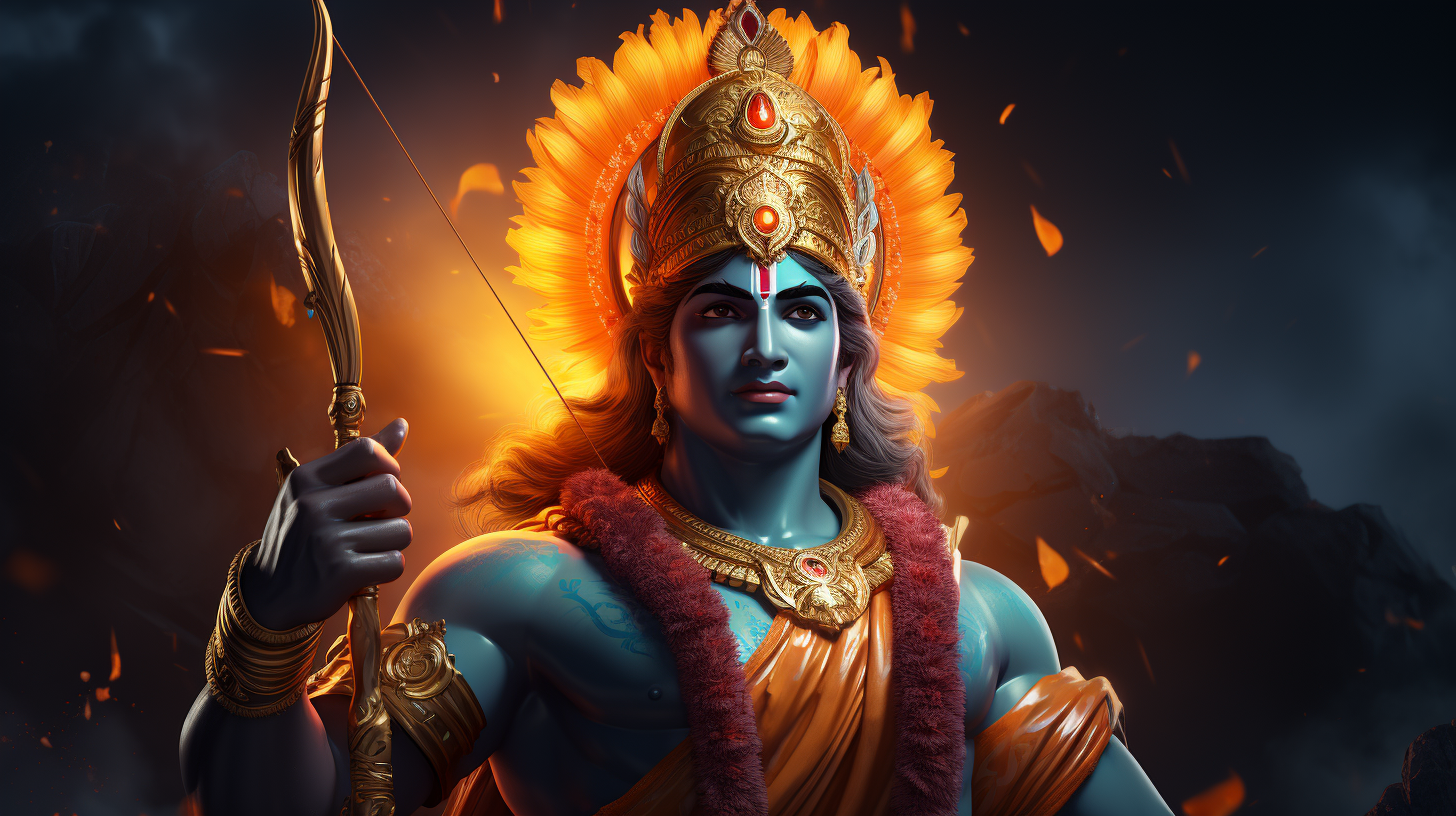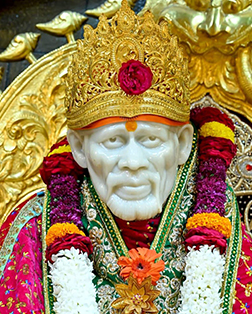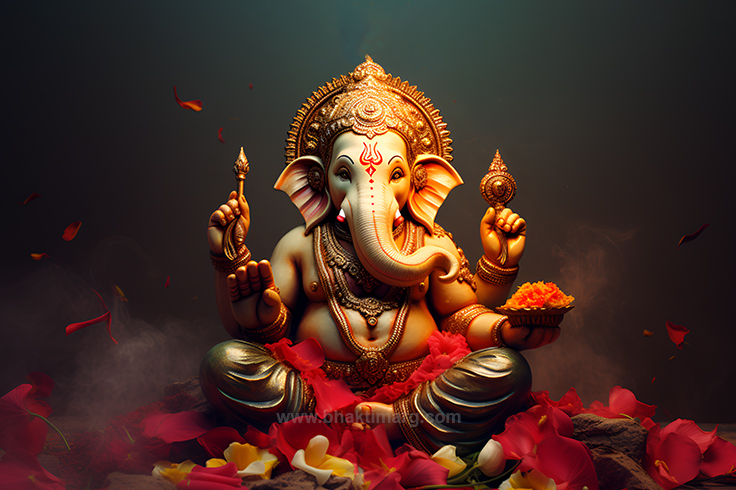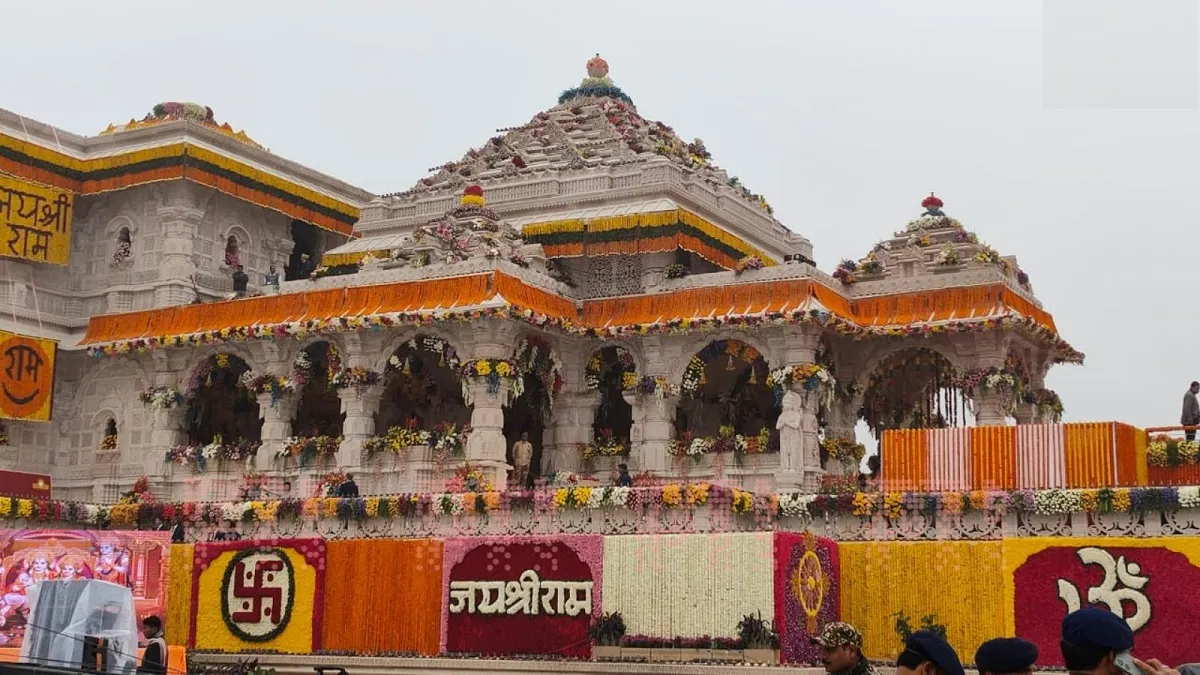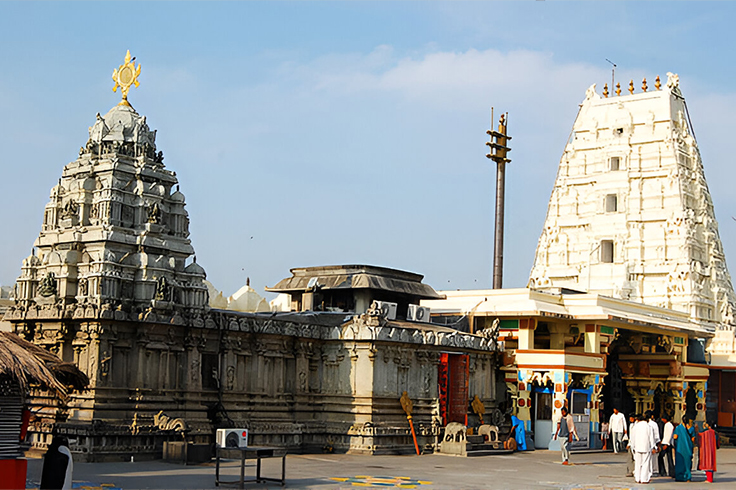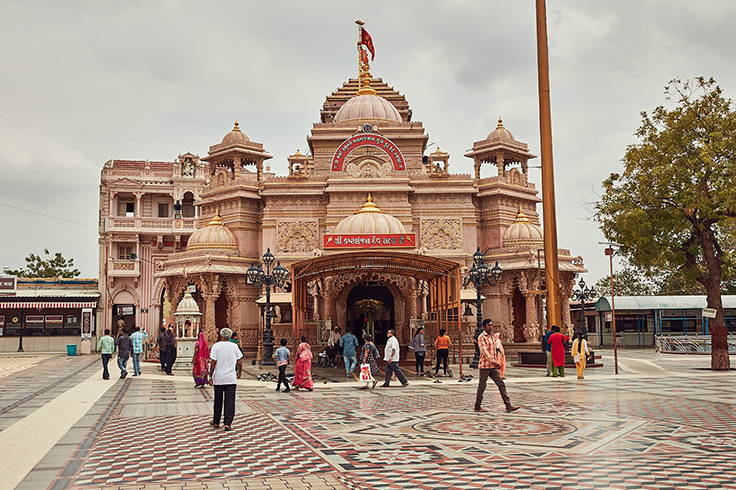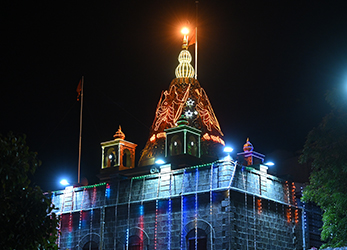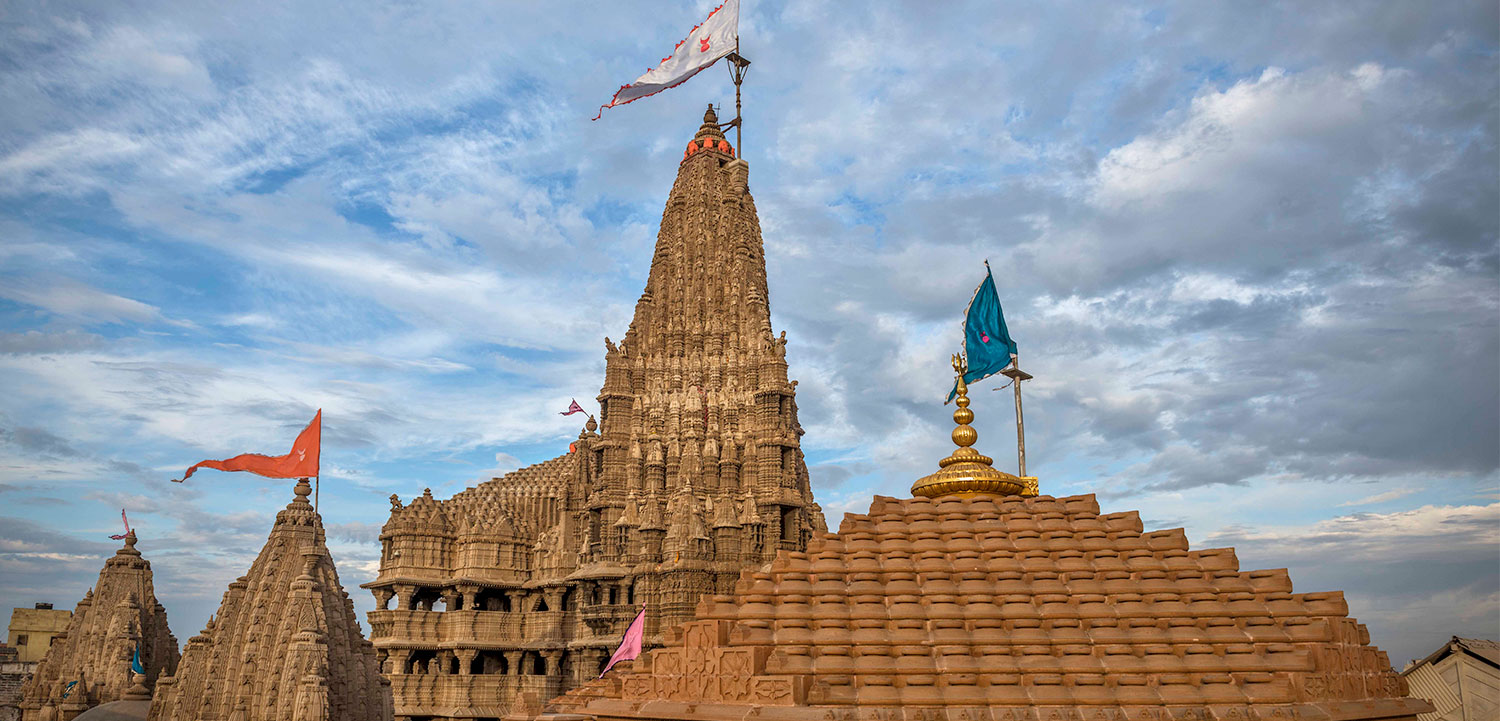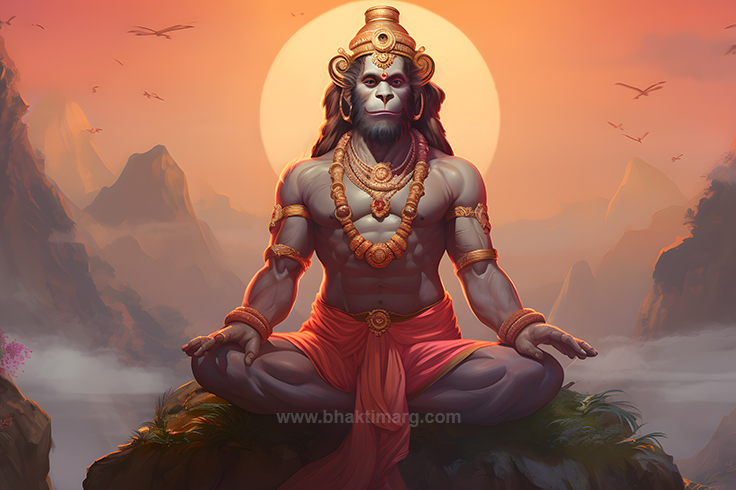
Lord Shree Hanuman
Dedication and devotion to anything help obtain positive results and success is a wide saying and experience. The same is implemented in Bhakti Marg, pure devotion to the lord without any kind of expectation or selfishness has always given one more than what is asked for. This path has led all in the right direction even the mightiest Lord Bajrangbali Hanuman is said to regain his path in life through his devotion to Lord Ram the incarnation of Bhagavan Shri Hari Vishnu.
Let’s get a look into the how and why of Hanumanji’s life and his journey on the path of Bhagti Marg being the mightiest praisable god himself.
The Birth of Hanuman
The whole legend of Hanuman’s birth is said to be linked with Bhagavan Shiv having the desire to serve his favorite Sri Hari Vishnu and stay with him in the mortal world as his devotee. He was born to Anjani a cursed Apsara who married the Vanar King Kesari, through the blessing of lord Varun when she was praying to lord Shiva to grant her child.
One story portrays Hanuman being born to Shiv and Parvati and lord Shiv asks her to entrust the child to Anjana and Kesari through the hands of Vayudev, and the epic Ramayan mentions another event for the birth. While King Dashrath of Ayodhya was performing rituals for the birth of their heir, for which he received sacred pudding, Anjana was praying at the same time. With the divine ordinance, a kite took a bite of it and moved across the forest, and a drop of it was delivered to Anjana who was praying. And with the divine orchestrate was born the incarnation of Mahadev hence called ‘ Shivansh’.
He was called Anjaniputra, Anajneya, and Anjani suta as the son of Anjana or Kesarinanadan, and Kesarisuta denoting the son of Kesari, but Hanuman’s birth name was Maruti, being the son of Maruth another name for Vaayu Dev. The name Hanuman was later renowned after his encounter with Lord Indra. Since he was born with the grace of Lord Pavan he is also known as Pavanputra Hanuman or Vayuputra Hanuman, there are many such interesting episodes behind his name there are said to be Hanuman 108 names, from which we would look into some. Shir Hanuman enacted several remarkable events rendering the ‘Thribhuvan’ i.e. the three worlds speechless with his antics and glories, and as he moved through people’s lives he started gaining different denominations.
Stories of Hanuman Ji and Entitled Names
Story Of Hanuman Name:
He was said to be legendary when it comes to mischief as he was of flickering nature, one such tale is of his childhood. He was sleeping in his cradle and saw the sun through a mango tree and thought it was a big shining mango. So the naive Anjaniputra took a leap towards the Surya dev and tried eating it, being a Shivansh he had insurmountable powers. Seeing that some child is about to eat Suryadev he uses his Vajrastra the most powerful weapon on Pawanputra Hanuman and little Anjaneya falls, seeing his Godson about to die, Vaayu Dev is enraged and halts the flow of air on earth which starts creating chaos and death of the beings and hence the Gods intervened. Seeing Vaayu Dev furious over his son’s death Indra Dev realized his mistake and asked for his forgiveness. Then Lord Shiva brought him back to life along with that all the gods graced the kid with numerous boons to satiate lord Varun’s anger. In this instance his jaw was disfigured with the Vajra hence he came to be known as ‘Baal Hanuman’ where Hanu means jaw.
How Hanuman Became Chiranjeevi:
After being brought to life from the deadly attack of Lord Indra to satiate Varun Dev’s anger and agony various boons were showered on Pawanputra. Among this, he received Lord Brahma’s blessing to be ‘Amar’ stating that if his death would hurt Varun Dev so much he granted him to never leave the Earth. So he would continue living till the end of time hence named ‘Cheeranjevi’ meaning one who will live forever the immortal being and be able to cast away fears, getting the name Sankat Mochan Hanuman.
Blessings That Gave Him Powers and Name:
Along with Brahmadev other gods also gave him a boon the one received from Surya Dev was a very unique power. The blessing stated he could change his form from as big as he wanted to as small as he wished, hence the name Mahakaya, the gigantic being. This boon allowed lord Hanuman to take the biggest form in which he leaped from the coast of Rameshwar to Lanka and reaching there he turned himself into as small as an ant to search Goddess Sita.
Why Was Anjaneya Brahmachari:
Shri Hanuman is popularly known as Baal Brahmachari or Ajeevan Brahmachari as he has followed asceticism all his life. The reasons behind this are varied but the main one is said to be his devotion toward Lord Shri Ram and his dedication to serving him for a lifetime. One of the key reasons behind Hanuman’s vow of celibacy comes from his role as the ultimate devotee of Lord Rama. his life was dedicated to serving Rama and aiding him in the search for Sita, Rama’s wife. It is said that Hanuman, in his devotion to Rama, made the vow of eternal celibacy to focus entirely on his service, ensuring that no worldly desire would ever distract him from his duty. In one scripture it is mentioned that when Hanuman went to rescue Goddess Sita and assure her Lord Ram would be coming for her she blessed him with eternal youth. Then he vowed to serve his Aradhya all his life without any distraction or deviation hence vowed celibacy.
How Hanuman Became Bajarangbali:
His name Bajrangbali is said to be related to the incident of being struck by Indra Dev with Vajra and was blessed to be as strong as Vajra, the strongest weapon. So the term Bajra is another word for vajra, and means the body, and Bali means the strongest hence the name Bajrangabali Hanuman. Another story for being called Bajrangbali is due to his action of painting his whole body with sindoor. Once he asked Mata Sita what is most liked by Lord Rama and Sita stated that the Sindoor she applied on her forehead gives immense happiness to Lord Rama. So the pure-hearted devotee applied the sindoor which is also called Bajrang to his body and he being the strongest being was named Bajrangbali henceforth.
Hanuman Being All Powerful:
Since at a young age, he was revived and blessed with numerous blessings he became invincible and the strongest alive. Being the invincible and one with ultimate power he was called Mahabali. Even so, with all the powers and ignorance young age led him to create chaos all over and prank many Rishi and Sages, and being fed up with all the antics of Maruti. They cursed him to forget all his powers and later be reminded by a knowledgeable person, which was done by Jambavant the Bear King during their search for Goddess Sita.
Hanuman Helping Vanar King Sugreev:
As the biggest devotee of Lord Ram, his first meeting with his Aradhya is said to be when Ram was distressed and searching for his beloved wife Sita. but very little is mentioned that when Shri Ram was a little kid in search of his lord Kesarinandan visited Bhagwan Ram and vowed to meet again someday when destiny agreed and the Lord needed his help, as he was to return to his kingdom to his parents and be filial. They met at Rishyamuk Mountain where Bajranbali was residing with Kishkinda’s king Sugriv who was overthrown by his brother amidst a misunderstanding over previous events. When Hanuman came face to face with Lord Ram he disguised himself as a Brahmin to test the two warriors approaching them. When he realized it was his Isht deva Prabhu Shree Ram he apologized and vowed to assist and serve him for a lifetime.
Lord Hanuman Proudly Being a Server of Lord Ram:
In the quest to search Mata Sita, the Vanarsena ended up at the last land on the south coast, getting a clue about the missing beloved of Shri Ram. To verify the same it was essential to follow the trail crossing the vast sea, and the only person who could achieve this was Mahabali Hanuman. However, he had forgotten his powers and here Jambavant the Great Bear King reminded him of his powers, and fighting the sea monster he reached Ashok Vatika the place Sita was kept captive, and introduced himself as ‘Ramdoot’ e. messenger of Shri Ram, giving her the gods message and providing her relief from the grief and assuring her that she would be saved from the abduction, so being denoted as ‘Sitashokvinanshnayaka’.
Burning the Golden Lanka:
When Lord Hanuman went to Lanka to find Mata Sita, after discovering her and delivering Lord Rama’s message, he allowed himself to be captured to gauge Ravana’s power. When he was captured Ravana as a method of punishment Ravana ordered Hanuman’s tail to be set on fire as punishment. Using his strength and divine powers, Hanuman broke free and, with his flaming tail, leaped across the city, setting Lanka ablaze. This act showcased his immense power and devotion to Rama. Following this event, Hanuman was honored with the name “Mahavira”, meaning “great hero.” This instance is a debt Lord Shiva collected in the Avatar or Lord Hanuman for his favorite devotee Nandi. This instance is said to be related to the event mentioned in Shiva Purana where Ravana visits Kailash Parvat to visit Shiva but was refused entry as he was in meditation. In anger, he insulted Nandi for being an animal and then Nandi cursed Ravana that all his arrogance, power, and wealth would be once burnt to ashes by an animal, so when Lord Shiva took Vanar Avatar he fulfilled his devotee’s word.
Hanuman The King of Monkey Kind:
The lord of Vanar as he was the strongest and blessed among all hence identified as Kapeeshwara, and as he was the one leading the Vanar Sena during the war against Ravan he was called Kapisenanayaka. Bajrangbali showcased his valor and strength along with courage throughout the wartime and later assisted Ram after his return to Ayodhya.
Display of Power During Lanka War:
Later during the war between Ram and Ravan, he supported them throughout, right from bringing them back from the capture of Ahiravana from Pataal to saving Laxmana’s life when he was severely injured from the enemy’s attack on Bajranbali Hanuman brought Sanjeevani herb along with the whole mountain hence is denoted as ‘Sanjeevananagahtre’ as he could not tell the difference between an herb and normal plant, he was then renowned as Lakshmana Prandatre.
This avatar of Hanuman is quite fierce and worshipped less. The legend of Panchmukhi Hanuman (the five-faced Hanuman) stems from an important episode in the Ramayana during the battle between Lord Rama and Ravana. According to the story, during this intense battle, Ravana’s brother, Ahiravana, captured Lord Rama and Lakshmana and took them to the netherworld (Patala). To rescue them, Hanuman assumed the powerful Panchmukhi (five-faced) form. Each of the five faces represented a different deity: Hanuman (east), Narasimha (south), Garuda (west), Varaha (north), and Hayagriva (upwards). This form granted Hanuman immense power and the ability to defeat Ahiravana by extinguishing five lamps burning in different directions simultaneously, thereby killing him and rescuing Rama and Lakshmana. The Panchmukhi form of Hanuman symbolizes immense strength, protection, and devotion, highlighting his ability to overcome any obstacle in the service of Lord Rama.
Shree Hanuman Ji Worship and Festival Celebration
Hanuman is denoted as Sankat Mochan so there is a belief that he would ward off any kind of evil spirit. He is a revered symbol of strength, devotion, and protection, and holds a significant place in Hindu worship. He is an embodiment of selfless service, unparalleled loyalty, and immense power. So many devotedly follow God Bajrangbali praises him, and mentions the benefits of reciting the same, through which countless devotees seek his blessings for courage, protection from evil, and success in life.
As Shri Hanuman has followed asceticism all his life hence it’s a belief that his followers should also follow the same path. Worshiping him is a common practice, especially on Tuesdays and Saturdays, as these days are considered highly auspicious for Hanuman devotees and protect his Bhakts from the infamous Shani Dev Prokop. The rituals of worship involve chanting the Hanuman Chalisa a 40-verse hymn dedicated to Lord Hanuman, which is believed to remove all obstacles and bring peace and success, offering red vermillion (sindoor) mixed with mustard oil, and lighting a lamp in his honor. Devotees offer garlands of marigolds, and sweet dishes such as laddoos, and coconuts. Some even believe that service to Lord Ram is service to Sankat Mochan Shri Bajrangbali, as serving his master would please him even more. Today the most staunch followers of Bajrangbali or Mahabali Hanuman are the Kushti players who invoke the blessing of power by chanting Jai Bajrangbali before starting their practice to grant them strength.
Lord Hanuman is often depicted in temples holding a mace and carrying a mountain, symbolizing his heroic deeds in the Ramayana, particularly his role in finding Sita and bringing the life-saving herb to heal Lakshmana. He is also considered the ultimate Brahmachari (celibate) and is revered for his undivided devotion to Lord Rama. Hence girls are advised not to worship Anjaneya or enter his Mandir as he was a Brahmachari following asceticism all his life.
Festivals and Famous Mandir of Pawanputra Hanuman:
The most significant festival dedicated to Lord Hanuman is Hanuman Jayanti, which celebrates his birth. It is celebrated on different dates across India, generally during Chaitra Purnima (March-April), marking the full moon day of the Chaitra month. In some southern regions, such as Tamil Nadu and Kerala, Hanuman Jayanti is celebrated in December (Margazhi month).
Devotees observe fasts, recite the Hanuman Chalisa, and visit temples to offer prayers. The day begins early with special pujas and abhishekams (ritual bathing) of Hanuman’s idols with water, milk, and honey; some temples also organize Akhand path (continuous recitation) of the Ramayana or Sundara Kanda (the section detailing Hanuman’s exploits). It is believed that worshiping Hanuman on this day brings good fortune, health, and protection from negative energies. Devotional songs, such as Hanuman Aarti, Hanuman Mantra, and Hanuman Bhajans, are recited while praying to the god.
Many devotees carry processions and have celebrations in Hanuman temples, some of the famous temples with elaborate celebrations are as follows,
Sarangpur Hanuman Mandir, Gujarat:
The Sarangpur Hanuman Mandir in Gujarat is one of the most revered Kesarinandan temples in India. It is dedicated to Kastbhanjandev Hanuman, the remover of sorrows and destroyer of evil forces. Located in the Botad district, the temple is especially known for its healing powers, with devotees coming here to seek relief from black magic and evil spirits. The temple’s sanctum houses a unique idol of Lord Hanuman, adorned with a massive mace, and it is said that just by visiting the temple, devotees are relieved of their sufferings.
Hanumansetu Mandir, Lucknow:
Hanumansetu mandir in Lucknow, Uttar Pradesh, is another prominent Hanuman temple, located near the Gomti River. It was said to have been built by an Indian Saint Neem Karoli Baba and after a huge flood in 1960, it was rebuilt by Dr. Rajendra Prasad, India’s first President. The temple is famous for its large idol of Lord Hanuman in a sitting posture, with devotees flocking here on Tuesdays and Saturdays to offer prayers. The temple’s serene location and grand celebrations during Hanuman Jayanti make it a popular pilgrimage site in northern India.
Devi Suvarchala Temple, Telangana:
This is one of the unique temples dedicated not only to Lord Hanuman but also to Devi Suvarchala, his wife according to some lesser-known scriptures. While Hanuman is predominantly known as a celibate (Brahmachari), some ancient texts describe his marriage to Suvarchala, the daughter of the sun god, as a union that was purely spiritual and symbolic of his unshakable commitment to duty. Located in Mangalagiri, Andhra Pradesh, this temple holds significance for devotees who worship both Hanuman and Suvarchala for spiritual strength and divine blessings.
Shree Salasar Balaji Hanuman Mandir, Rajasthan:
Located in Salasar in the Churu district of Rajasthan, this temple is one of the most revered Hanuman temples in India. Devotees from across the country visit this sacred shrine to seek blessings from Lord Hanuman, who is fondly called Balaji here. The temple is known for its unique idol of Hanuman, adorned with a mustache and beard. It is a significant pilgrimage site, especially during the Hanuman Jayanti festival. The temple is also believed to grant wishes, and visitors offer special prayers for success, protection, and fulfillment of desires.
Symbolism and Worship in Everyday Life
Worship of Lord Hanuman goes beyond grand celebrations and temples, in everyday life, people seek his blessings to overcome obstacles, gain courage, and stay focused on their duties. His image is often seen on doorways and in vehicles, symbolizing protection. Many athletes and individuals in strenuous professions, such as soldiers, and wrestlers revere Mahabali for his strength and resilience. Hanuman is also a favorite among students as they recite the Hanuman Chalisa before exams for mental clarity and concentration. His unparalleled devotion to Lord Rama also makes him a symbol of devotion enlightening the Bhakti Marg and inspiring millions of devotees to serve others selflessly.
Worshiping Pawanputra Hanuman is deeply embedded in Hindu tradition, offering devotees hope, strength, and protection from evil. Whether through Hanuman Chalisa recitations, temple visits, or singing Hanuman Bhajan and Hanuman Aarti on grand festivals like Hanuman Jayanti, his presence is felt strongly in the lives of millions. The famous Hanuman temples, like Sarangpur, Hanumansetu, and Khamman district temples, further enrich the spiritual journey of devotees. Worshiping Him is not just about seeking material gains but about finding the inner strength to lead a life of duty, service, and unwavering devotion.




